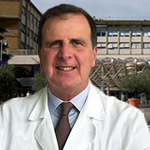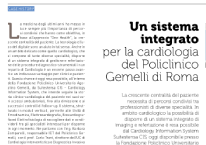An integrated system for the Cardiology department of Policlinico Gemelli
The growing centrality of the patient requires shared pathways between professionals of different specialties. In the field of cardiology, the possibility of having an integrated imaging and reporting system is made possible by the Suitestensa CardioVascular Information System CVIS, now available at Fondazione Policlinico Universitario Agostino Gemelli in Rome. We have deepened the theme in three interviews with an engineer and two clinicians to understand technical aspects and advantages that the product allows from a practical point of view.

Medicine in recent years has increasingly highlighted the importance of shared pathways that have as their goal, based on the "One Health" approach, the increasing centrality of the patient. Technology and the use of digital techniques are helping in this regard.
Even in such a delicate field as cardiology, which is composed of many different subspecialties, having an integrated system for the management and reporting of diagnostic and instrumental procedures of the cardiology department is a huge step forward and an undisputed advantage for both clinicians and patients.
This opportunity is now made possible, within the Fondazione Policlinico Universitario Agostino Gemelli, by Suitestensa CVIS – Cardiovascular Information System, which aims to follow the clinical-cardiological history of the patient in its various outpatient accesses, hospitalization until discharge and subsequent follow-ups.
The system, structured in vertical modules, allows the Haemodynamics, Electrocardiography (EKG), Echocardiography and Electrophysiology Units to collect data and share them among the interested specialists in order to have all the information available at any time. We talked about this with Barbara Zomparelli, CVIS IT manager at Policlinico Gemelli, with Professor Carlo Trani, director of the Interventional Cardiology and Invasive Diagnostics Unit at Gemelli, and with Doctor Antonella Lombardo, head of Echocardiography at Gemelli, who illustrated the technical specifications of the project and the main benefits offered: from the product to routine clinical practice.
Interview with Prof. Carlo Trani - Policlinico Gemelli in Rome
Suitestensa CVIS platform, technical aspects
The platform is modular, for each area of interest it has a separate module along with the master data of each patient. If the patient has performed multiple cardiological examinations, these are collected in a single platform that will form the patient's cardiology record. Although Cath lab is very different from the ultrasound field of the echocardiography, the physician, when logging in, has all the information he or she needs for the diagnosis, along with other related clinical information.
The platform is very well integrated into the hospital information system through many types of integrations. «First and foremost, it has an integration with the corporate app, so physicians and operators access the platform with their corporate credentials. Also important is the integration with the corporate MPI, with the centralized registry that allows the patient to be uniquely identified throughout his or her clinical history within the Foundation; no less important are the integrations with departments, which can make requests toward the CVIS conveyed through HL7 integrations to the platform. When physicians access the platform, they find the list of patients to be evaluated, the exams to be performed and, similarly, at the end of the exam, the reports they finalize on the platform return, through the HL7 integration, to the departments», says Mrs. Zomparelli.
The departments can then view the reports and, thanks to an integration between cardiology PACS and corporate PACS, the images related to the examinations performed. «The system is compatible with most devices, as long as they are not obsolete, i.e., diagnostic machines that adopt the DICOM standard. Echocardiography devices are considered obsolete if they are more than 5 years old, while angiographs can 'last' up to 8 years.». Hence the importance of having equipment as recent as possible.
At the moment, the platform also receives data from patients coming from facilities outside Gemelli, as long as they are part of the Foundation, such as Columbus, which is now Covid Hospital.
This allows physicians to view exams performed at Covid Hospital without physically moving patients. With respect to sensitive issues, such as the new GDPR on privacy, the system seems perfectly in line with the regulation. «The platform can only be accessed by authorized staff. When the physician logs into the system with their credentials, they are uniquely identified. The data center is very attentive to data protection, there are numerous activities of back-up and maintenance of the system to safeguard the data. When the patient logs in the Foundation provides appropriate consents, which are also inherited from the CVIS platform».
Clinical benefits
«It has been a great advancement to have online on the same system we use every day to report echocardiography reports and related images. Think about planning valvular procedures or structural interventional procedures: evaluating firsthand, with the help of fellow sonographers, the images in the room during the procedure is priceless», says Prof. Trani.
«A system that allows centralized management of care activities is an undisputed advantage for the patient, who becomes the center of care. For us, as clinicians, this system is totally in line with our current philosophy, which calls for the discussion of the most thorny cases in the presence of multiple professionals as a team in the “Heart Team”. In this sense this technology is very useful, allowing us to see the patient's imaging on a single platform», comments Dr. Lombardo. It is a system that in a single environment allows to store, manage and review images, associated with reports, which are inserted in the patient's record.
The workflow in a catheterization lab involves interaction between different professional figures (physicians, nurses, cardiology technicians), each of whom is familiar with the system using, depending on their area, dedicated data entry reporting forms. «All members of the department access the various units by entering personal and traceable credentials. At the end of the care pathway, however, the physician in charge of the patient draws up the clinical summary based on the information collected during the hospitalization. The software has an automatic worklist system, allowing us, after our programming and planning, to find the list of patients to be examined», concludes Dr. Lombardo. The module also adheres to the quality requirements of GISE, the Italian Society of Interventional Cardiology, thanks to its structure that manages reporting and data collection in addition to angiographic images. «The information included in the patient record permits research and statistics, as required by GISE, and possible scientific studies», Prof. Trani concludes.
Contact us for more information
Read other Clinical Stories
A career-long goal being realised
An interview with Professor Joachim Ehrlich Head of Cardiology and Electrophysiology St Josef’s Hospital in Wiesbaden, Germany...“
A technological dream come true
An interview with Professor Shmuel Banai, Director; Division of Cardiology, The Tel Aviv Souraski Medical Center, Tel Aviv, Israel



